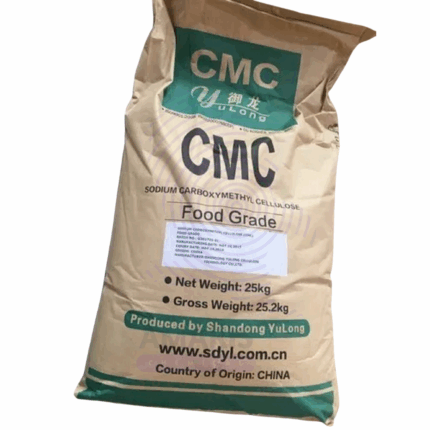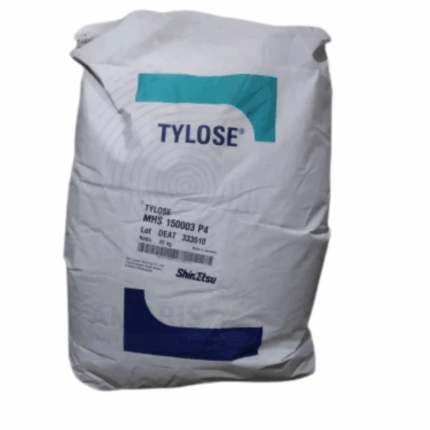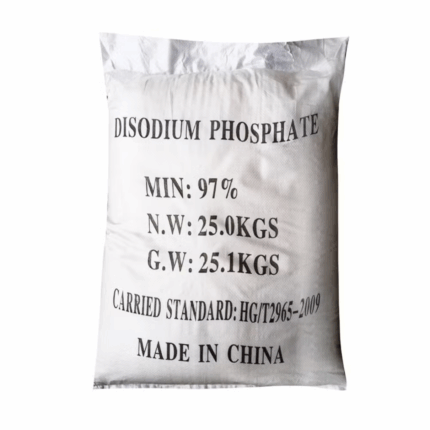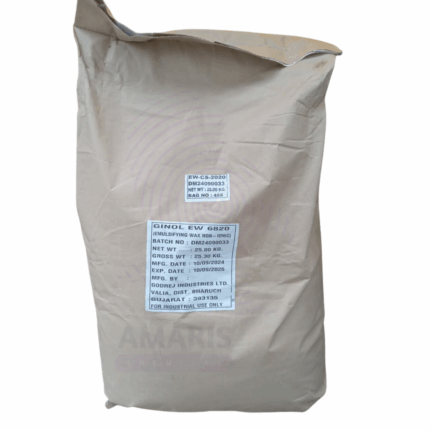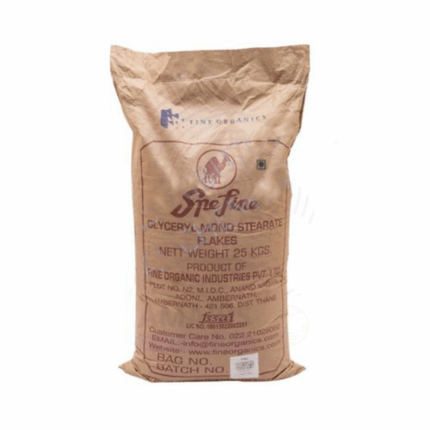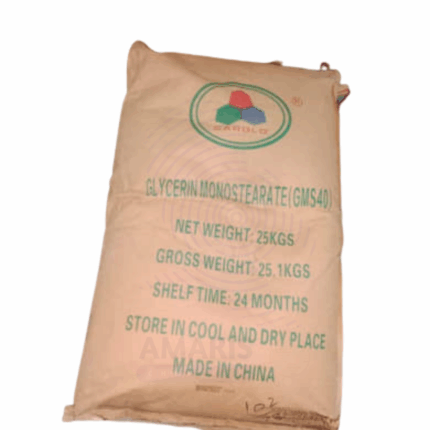
CMC Sodium (Carboxymethyl Cellulose Sodium)
CMC Sodium, or Carboxymethyl Cellulose Sodium, is a water-soluble anionic cellulose ether derived from natural cellulose. It appears as a white to off-white, odorless, tasteless powder or granule. Known for its excellent thickening, stabilizing, emulsifying, and water-retention properties, CMC is widely used in food, pharmaceutical, personal care, industrial, and detergent applications. It functions by modifying the rheological properties of solutions and suspensions, offering control over viscosity and flow. Its biocompatibility, non-toxicity, and biodegradability make it suitable for both human use and environmentally friendly formulations.
CMC Sodium (Carboxymethyl Cellulose Sodium) Uses
Primary Uses
- Food Industry (as Food Grade CMC)
- Used as a thickener, stabilizer, and emulsifier in products like ice cream, yogurt, jelly, bakery fillings, sauces, and beverages.
- Prevents ice crystal formation in frozen desserts and improves mouthfeel.
- Acts as a fat replacer in low-fat and calorie-reduced foods.
- Provides suspension stability in flavored milk and juice drinks.
- Designated as E466 in the EU as a permitted food additive.
- Pharmaceuticals
- Used as a binder, disintegrant, and stabilizer in tablets and capsules.
- Acts as a thickener in oral suspensions, syrups, creams, and gels.
- Improves mucoadhesion in oral and topical formulations for prolonged contact.
- Used in wound care products as a moisture-retentive agent.
- Personal Care & Cosmetics
- Functions as a viscosity modifier and stabilizer in lotions, creams, toothpaste, shampoos, and hair gels.
- Provides film-forming and conditioning effects in skin and hair care formulations.
- Offers stabilization for emulsions and suspensions in cosmetics.
- Detergents & Household Products (Detergent Grade CMC)
- Prevents soil redeposition on fabrics during washing.
- Enhances suspension stability in liquid detergents and cleaners.
- Improves viscosity and texture in cleaning pastes and gels.
- Industrial Applications
- Used in paper manufacturing as a surface sizing agent to improve printability and strength.
- In textile printing, it acts as a thickener for dye pastes.
- Serves as a binder and film former in ceramics, adhesives, and coatings.
- Used in paint and coatings for viscosity control and dispersion stability.
Secondary Uses
- Oil & Gas Industry
- Used in drilling fluids as a viscosity modifier and fluid loss reducer.
- Improves the stability of drilling muds under varying temperature and pressure conditions.
- Construction
- Acts as a water-retaining agent and binder in cement, mortar, and plaster formulations.
- Enhances workability, reduces cracking, and improves adhesion.
- Agriculture
- Used in pesticide formulations for improved suspension and application.
- Acts as a soil conditioner to enhance water retention in dry soils.
- Printing Inks
- Improves flow properties and suspension stability in water-based inks.
- Biomedical Research
Used in hydrogels and tissue engineering for drug delivery systems and scaffolding due to its biocompatibility and gel-forming ability.
- Basic Identification Attributes
- Chemical Name (IUPAC): Sodium carboxymethyl cellulose
- Common/Trade Name: CMC Sodium
- CAS Number: 9004-32-4
- HS Code: 3912.31.00
- Molecular Formula: Variable (C₆H₇O₂(OH)₂CH₂COONa)n
- Synonyms:
- Sodium CMC
- Carboxymethylcellulose sodium
- Cellulose gum
- E466 (food grade)
- Physical & Chemical Properties
- Physical State: Powder or granules
- Color & Odor: White to off-white; odorless and tasteless
- Solubility: Freely soluble in cold or hot water; insoluble in most organic solvents
- pH (1% solution): 6.0–8.5
- Viscosity: Ranges from 10 to 10,000 cps depending on grade and concentration
- Moisture Content: Typically ≤10%
- Stability: Stable under normal conditions; hygroscopic
- Safety & Hazard Attributes
- Hazard Class (GHS): Not classified as hazardous
- NFPA Ratings:
- Health: 0
- Flammability: 1
- Reactivity: 0
- Exposure Limits: Not established; considered safe under normal use
- Toxicity: Non-toxic, non-sensitizing, and non-irritant in typical use concentrations
- Reactivity: Inert under normal conditions
- Storage & Handling Attributes
- Storage Conditions: Store in a cool, dry area in tightly closed containers
- Container Type: Paper or plastic bags with moisture-proof lining or drums
- Shelf Life: Up to 2 years when stored properly
- Special Handling: Avoid contact with moisture; use dust protection during handling
- Regulatory & Compliance Attributes
- FDA Status: GRAS (Generally Recognized As Safe) under 21 CFR §182.1745 (for food use)
- EU Food Additive Code: E466
- REACH Status: Registered
- Transportation: Not regulated as hazardous material
- Waste Disposal: Biodegradable; dispose in accordance with local regulations
- Environmental & Health Impact
- Ecotoxicity: Low environmental risk; safe for aquatic and terrestrial environments
- Persistence: Biodegradable
- Bioaccumulation: Not expected
- Carcinogenicity/Mutagenicity: Not classified as carcinogenic or mutagenic
- Biodegradability: Readily biodegradable under aerobic conditions
-
Safety Handling Precautions
PPE:
- Dust mask
- Safety goggles
- Gloves if prolonged handling is expected
Handling Measures:
- Avoid dust generation
- Ensure adequate ventilation
- Do not mix with strong oxidizers
Storage Measures:
- Keep container tightly sealed
- Avoid humidity and direct contact with moisture
- Use FIFO inventory method
Hygiene Practices:
- Wash hands after handling
- Avoid eating or drinking while handling
First Aid Measures
- Inhalation: Move to fresh air; rinse mouth; seek medical help if irritation occurs
- Skin Contact: Wash with soap and water; seek attention if irritation persists
- Eye Contact: Flush eyes with water for at least 15 minutes; seek medical advice if needed
- Ingestion: Non-toxic in small amounts; rinse mouth and drink water; seek help if large quantity is ingested
Firefighting Measures
- Fire Hazards: Combustible at high temperatures
- Extinguishing Media: Water spray, foam, CO₂, or dry chemical
- Special Precautions: Firefighters should wear protective equipment and breathing apparatus
- Decomposition Products: May emit carbon monoxide and carbon dioxide when burned


 Preservatives(food)
Preservatives(food) Flavor Enhancers
Flavor Enhancers Acidulants
Acidulants Sweeteners
Sweeteners Antioxidants
Antioxidants Colorants(food)
Colorants(food) Nutraceutical Ingredients (food)
Nutraceutical Ingredients (food) Nutrient Supplements
Nutrient Supplements Emulsifiers
Emulsifiers
 Collectors
Collectors Dust Suppressants
Dust Suppressants Explosives and Blasting Agents
Explosives and Blasting Agents Flocculants and Coagulants
Flocculants and Coagulants Frothers
Frothers Leaching Agents
Leaching Agents pH Modifiers
pH Modifiers Precious Metal Extraction Agents
Precious Metal Extraction Agents
 Antioxidants(plastic)
Antioxidants(plastic) Colorants (Pigments, Dyes)
Colorants (Pigments, Dyes) Fillers and Reinforcements
Fillers and Reinforcements Flame Retardants
Flame Retardants Monomers
Monomers Plasticizers
Plasticizers Polymerization Initiators
Polymerization Initiators Stabilizers (UV, Heat)
Stabilizers (UV, Heat)
 Antifoaming Agents
Antifoaming Agents Chelating Agents
Chelating Agents Coagulants and Flocculants
Coagulants and Flocculants Corrosion Inhibitors
Corrosion Inhibitors Disinfectants and Biocides
Disinfectants and Biocides Oxidizing Agents
Oxidizing Agents pH Adjusters
pH Adjusters Scale Inhibitors( water)
Scale Inhibitors( water)
 Antioxidants(cosmetic)
Antioxidants(cosmetic) Emollients
Emollients Fragrances and Essential Oils
Fragrances and Essential Oils Humectants
Humectants Preservatives
Preservatives Surfactants(cosmetic)
Surfactants(cosmetic) Thickeners
Thickeners UV Filters
UV Filters
 Fertilizers
Fertilizers Soil Conditioners
Soil Conditioners Plant Growth Regulators
Plant Growth Regulators Animal Feed Additives
Animal Feed Additives Biostimulants
Biostimulants Pesticides (Herbicides, Insecticides, Fungicides)
Pesticides (Herbicides, Insecticides, Fungicides)
 Active Pharmaceutical Ingredients (APIs)
Active Pharmaceutical Ingredients (APIs) Excipients
Excipients Solvents(pharmaceutical)
Solvents(pharmaceutical) Antibiotics
Antibiotics Antiseptics and Disinfectants
Antiseptics and Disinfectants Vaccine Adjuvants
Vaccine Adjuvants Nutraceutical Ingredients (pharmaceutical)
Nutraceutical Ingredients (pharmaceutical) Analgesics & Antipyretics
Analgesics & Antipyretics
 Analytical Reagents
Analytical Reagents Solvents(lab)
Solvents(lab) Chromatography Chemicals
Chromatography Chemicals Spectroscopy Reagents
Spectroscopy Reagents microbiology-and-cell-culture-reagents
microbiology-and-cell-culture-reagents Molecular Biology Reagents
Molecular Biology Reagents Biochemical Reagents
Biochemical Reagents Inorganic and Organic Standards
Inorganic and Organic Standards Laboratory Safety Chemicals
Laboratory Safety Chemicals Specialty Laboratory Chemicals(Special Laboratory Equipment)
Specialty Laboratory Chemicals(Special Laboratory Equipment)
 Demulsifiers
Demulsifiers Hydraulic Fracturing Fluids
Hydraulic Fracturing Fluids Scale Inhibitors(oil)
Scale Inhibitors(oil) Surfactants(oil)
Surfactants(oil) Drilling Fluids
Drilling Fluids
 Dyes and Pigments
Dyes and Pigments Bleaching Agents
Bleaching Agents Softening Agents
Softening Agents Finishing Agents
Finishing Agents Antistatic Agents
Antistatic Agents
 Admixtures
Admixtures Waterproofing Agents
Waterproofing Agents Sealants and Adhesives
Sealants and Adhesives Curing Compounds
Curing Compounds Concrete Repair Chemicals
Concrete Repair Chemicals Anti-Corrosion Coatings
Anti-Corrosion Coatings
 Surfactants(cleaning)
Surfactants(cleaning) Builders
Builders Enzymes
Enzymes Solvents (Cleaning)
Solvents (Cleaning) Fragrances
Fragrances
 Electronic Chemicals
Electronic Chemicals Catalysts
Catalysts Lubricants
Lubricants Photographic Chemicals
Photographic Chemicals Refrigerants
Refrigerants Automotive chemicals
Automotive chemicals Pyrotechnic Chemicals
Pyrotechnic Chemicals
 Biodegradable Surfactants
Biodegradable Surfactants Bio-based Solvents
Bio-based Solvents Renewable Polymers
Renewable Polymers Carbon Capture Chemicals
Carbon Capture Chemicals Wastewater Treatment Chemicals
Wastewater Treatment Chemicals
 Pigments
Pigments Solvents(paint)
Solvents(paint) Specialty Coatings
Specialty Coatings Binders/Resins
Binders/Resins Additives
Additives Driers
Driers Anti-Corrosion Agents
Anti-Corrosion Agents Functional Coatings
Functional Coatings Application-Specific Coatings
Application-Specific Coatings
 Fresh Herbs
Fresh Herbs Ground Spices
Ground Spices Whole Spices
Whole Spices Spice Blends
Spice Blends Dried Herbs
Dried Herbs
 Leavening Agents
Leavening Agents Dough Conditioners
Dough Conditioners Flour Treatments
Flour Treatments Fat Replacers
Fat Replacers Decoratives
Decoratives Preservatives(baking)
Preservatives(baking)
 Plasticizers & Softeners
Plasticizers & Softeners Reinforcing Agents
Reinforcing Agents Adhesion Promoters
Adhesion Promoters Vulcanizing Agents
Vulcanizing Agents Antidegradants
Antidegradants Blowing Agents
Blowing Agents Fillers & Extenders
Fillers & Extenders Accelerators & Retarders
Accelerators & Retarders





